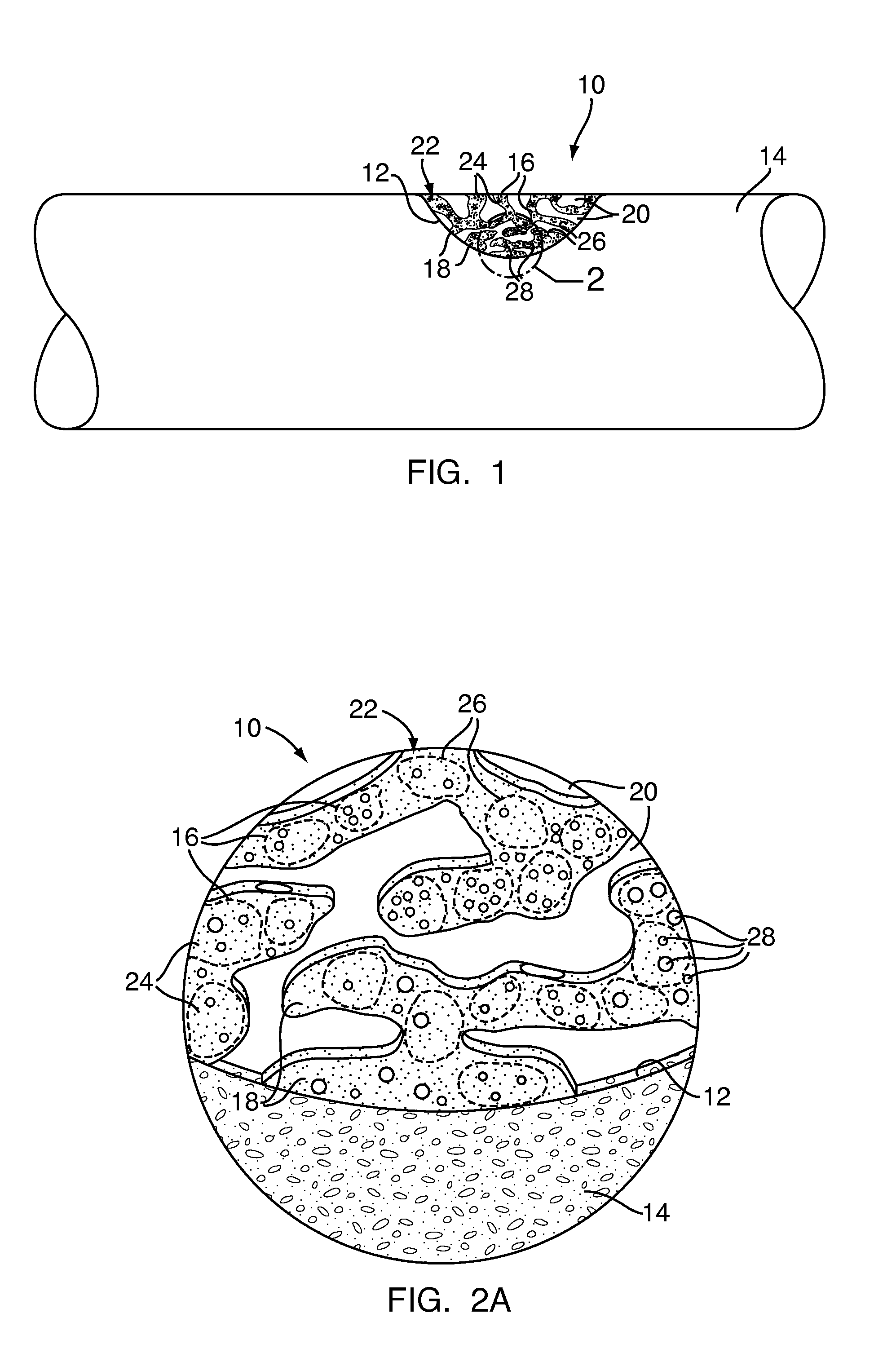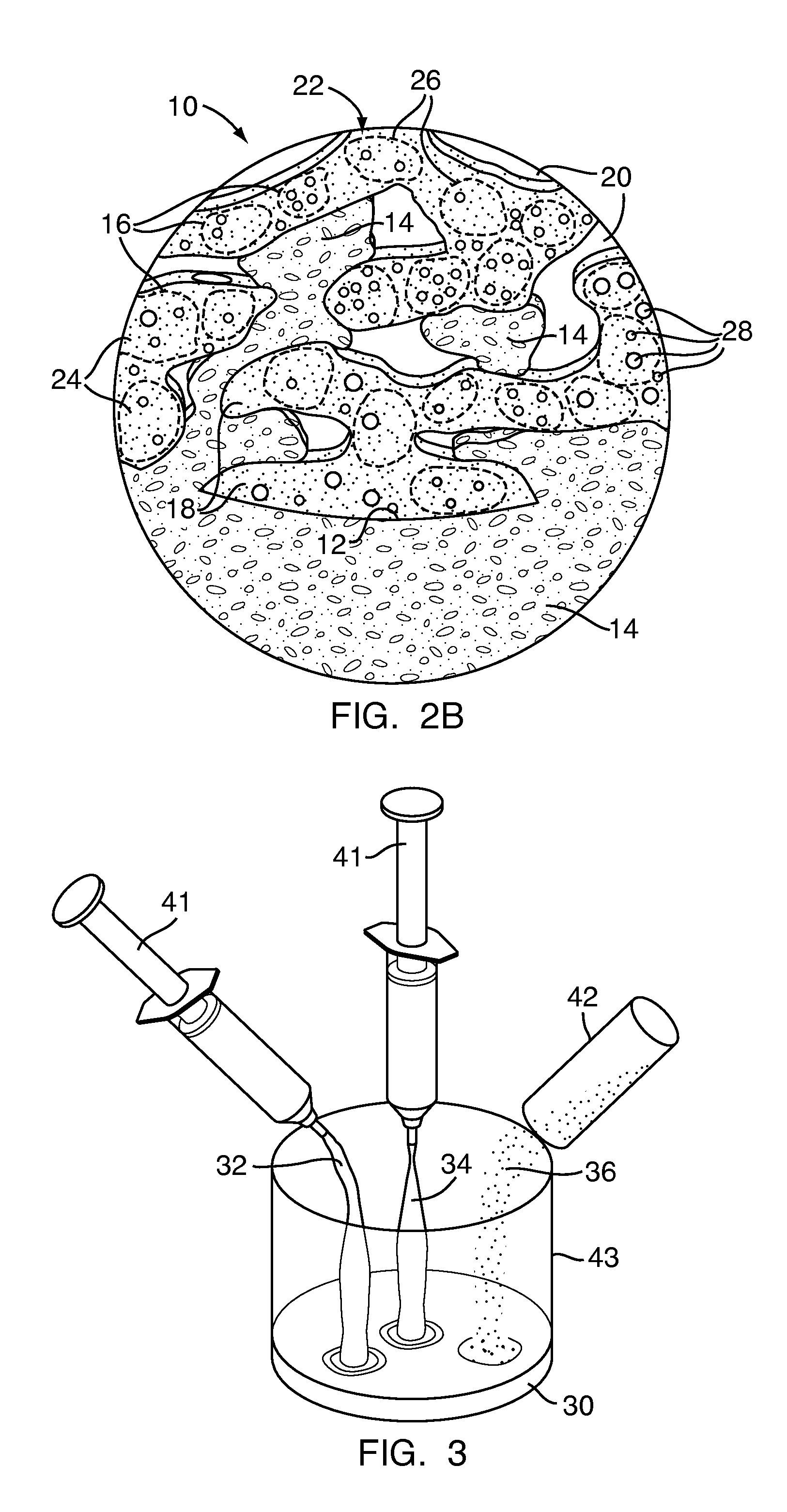Polymeric bone defect filler
a polymer and bone filler technology, applied in the field of polymer bone filler and bone repair compositions, can solve the problems of bone filler washout, missing bone proportion that must be replaced, removal of a portion of bone also requiring replacement, etc., to achieve sufficient mechanical strength, improve material expansion and contamination characteristics, and improve pore interconnection.
- Summary
- Abstract
- Description
- Claims
- Application Information
AI Technical Summary
Benefits of technology
Problems solved by technology
Method used
Image
Examples
exemplary embodiment 1
[0090]Exemplary Embodiment 1 is bone defect filler 10 having a low concentration of powdered granules as the particulate polymer 16. The particles 24 of the particulate polymer 16 of Exemplary Embodiment 1 are less than eight tenths of a millimeter (0.8 mm) in size. Exemplary Embodiment 1 has a twenty percent (20%) concentration of particulate polymer 16 as a percent of total mass and a fifty five percent (55%) concentration of particulate polymer 16 as a percent of total volume. Exemplary Embodiment 1 is readily mixable, and, after initial mixing, handles similarly to the control. Additionally, Exemplary Embodiment 1 is injectable through a large gauge cannula or may be packed into the bone defect 12. When fully cured, Exemplary Embodiment 1 resembles the control in appearance.
exemplary embodiment 2
[0091]Exemplary Embodiment 2 is bone defect filler 10 having a low concentration of small granules as the particulate polymer 16. The particles 24 of the particulate polymer 16 of Exemplary Embodiment 2 are between eighth tenths of a millimeter and one and six tenths of a millimeter (0.8-1.6 mm) in size. Exemplary Embodiment 2 has a twenty percent (20%) concentration of particulate polymer 16 as a percent of total mass and a sixty three percent (63%) concentration of particulate polymer 16 as a percent of total volume. Exemplary Embodiment 2 mixes well and handles similar to the control after mixing. Additionally, Exemplary Embodiment 2 is injectable through a cannula large enough to allow the granules to pass or may be packed into the bone defect 12. When fully cured, Exemplary Embodiment 2 resembles the control in appearance.
exemplary embodiment 3
[0092]Exemplary Embodiment 3 is bone defect filler 10 having a low concentration of large granules as the particulate polymer 16. The particles 24 of the particulate polymer 16 of Exemplary Embodiment 3 are between one and six tenths of a millimeter and three and two tenths of a millimeter (1.6-3.2 mm) in size. Exemplary Embodiment 3 has a twenty percent (20%) concentration of particulate polymer 16 as a percent of total mass and a sixty five percent (65%) concentration of particulate polymer 16 as a percent of total volume. Exemplary Embodiment 3 handles similar to the control and can easily flow and be poured or applied via spatula or similar tool to a bone defect 12. However, Exemplary Embodiment 3 is not injectable through a cannula as the particles 24 are too large. When fully cured, Exemplary Embodiment 3 resembles the control in appearance.
PUM
| Property | Measurement | Unit |
|---|---|---|
| diameter | aaaaa | aaaaa |
| diameter | aaaaa | aaaaa |
| diameter | aaaaa | aaaaa |
Abstract
Description
Claims
Application Information
 Login to View More
Login to View More - R&D
- Intellectual Property
- Life Sciences
- Materials
- Tech Scout
- Unparalleled Data Quality
- Higher Quality Content
- 60% Fewer Hallucinations
Browse by: Latest US Patents, China's latest patents, Technical Efficacy Thesaurus, Application Domain, Technology Topic, Popular Technical Reports.
© 2025 PatSnap. All rights reserved.Legal|Privacy policy|Modern Slavery Act Transparency Statement|Sitemap|About US| Contact US: help@patsnap.com



